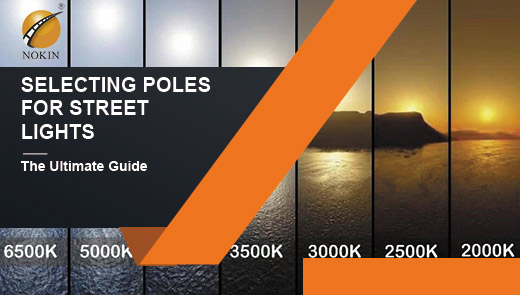Wattage vs Lumens: Know the Difference for Better Lighting
Mar 12, 2025
When choosing lighting products, many people often struggle with the concepts of wattage and lumens, and misperceptions can lead to high energy bills and less-than-ideal lighting results. In fact, a clear distinction between wattage and lumens plays a key role in making informed decisions in home, commercial or outdoor lighting scenarios.
In the past, when selecting solar street lights, some people used to judge the lighting capacity based on the wattage. If you want the street light to be brighter, you will often choose a higher wattage. But in fact, the wattage is not an indicator of the brightness of the street light, but is used to measure the energy consumption, i.e. the amount of electricity consumed by the street light to produce light.
The higher the wattage of a solar street light, the higher the power consumption, which may lead to insufficient battery life under the same solar power supply conditions, requiring more frequent maintenance and replacement of batteries, thereby increasing the cost of use.
Take a 40-watt solar street light as an example, under ideal lighting conditions, it consumes 40 watts of electricity per hour, which requires higher performance of solar panels and batteries.
Nowadays, with technological advances, new types of energy-saving solar street lights are emerging. These fixtures are able to produce the same brightness (lumens) as higher wattage streetlights while consuming fewer watts (less energy). For example, whereas a 40-watt solar streetlight used to produce 380 to 460 lumens of light, the same brightness can now be achieved with just a 5-watt high-efficiency LED solar streetlight.
When comparing two solar streetlights with the same number of lumens (brightness) but different wattages, the lower the wattage, the more energy efficient the streetlight. The luminous efficiency of a lamp is usually measured in lumens per watt (lm/W), the higher the lumens per watt, the higher the efficiency of the lamp, and the more maintenance costs we can save in the long run.

Lumen is the unit used to measure the brightness of the light. The higher the number of lumens, the brighter the light; the lower the number of lumens, the dimmer the light.
Nowadays, when choosing solar street lights based on brightness, we should focus on the number of lumens rather than the number of watts. For example, a 5-watt LED solar street light is brighter than a 50-watt solar street light, and that's where lumens come into play. A 5-watt LED light produces approximately 450 - 500 lumens.
LED lighting technology is widely used in the field of solar street lights, and it is able to maintain or even increase the number of lumens while reducing energy consumption. For example, if a 150-watt solar streetlight with a brightness of 2,600 lumens is replaced with a 25-watt LED solar streetlight, the energy consumption of the new streetlight will be significantly reduced, yet the brightness will remain the same. LED lighting technology reduces energy consumption by up to 93% compared to conventional high-wattage solar streetlights, thanks to the longer service life of LED lamps and their lower energy consumption. Therefore, LED solar street lights are not only more energy efficient, but also cheaper to use.
Wattage can be analogized to the speed of a car, but it measures not the speed, but the rate of energy flow in the power system. In the case of a solar streetlight system, the wattage reflects the rate at which the streetlight consumes electrical energy.
Lumens, on the other hand, can be seen as a direct measure of brightness. This means that lumens measure the amount of visible light produced that is visible to the human eye, regardless of energy consumption (wattage). In the case of a solar street light, lumens determine how well it actually illuminates the road.
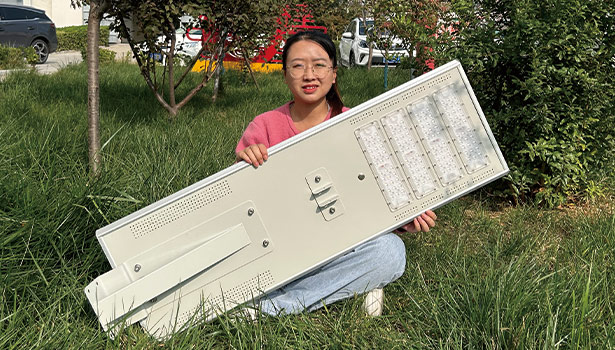
For example, when choosing solar street lights for community road lighting, according to the width of the road and the surrounding environment, choose the appropriate number of lumens of the product, not only to ensure the lighting effect, but also to avoid energy waste.
Color temperature factor: color temperature has nothing to do with the wattage and lumens, it refers to the degree of light “warm and cold”. Warm color temperature is similar to the traditional incandescent light bulbs issued by the light, to create a warm atmosphere; and cold light is more harsh, such as the common cold white LED light, can provide clear and bright lighting effect. In parks and other recreational areas, you can choose the warm color temperature of the solar street lamps; in the traffic avenue and other places that require a clear vision, it is suitable for the street lamps with cold color temperature.
Wattage is a unit to measure energy consumption. In solar street light system, although its energy comes from solar energy, the wattage also determines the consumption of electricity by the street light. For example, a 60-watt solar streetlight consumes 60 watts of electricity per hour, which means that a more powerful solar panel and a better quality battery are needed to guarantee its continuous power supply. Due to the limited technology of early solar street lights, there was a time when a specific brightness level was associated with a high wattage. But now, with the development of LED technology, which can produce more light at lower wattage, we can no longer judge the brightness simply based on the wattage, but need to choose based on the number of lumens.
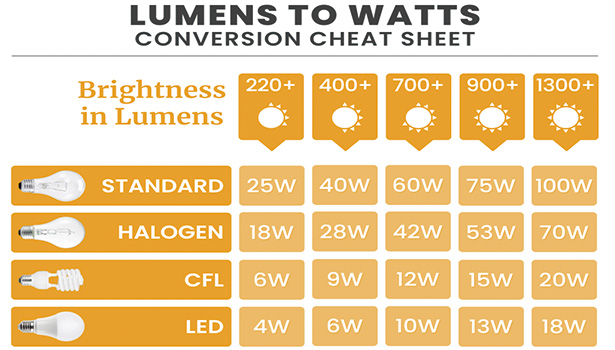
Lumen is a unit of visible light energy. The higher the lumen count, the brighter the light. Nowadays, all solar street light manufacturers will label lumens in the product parameters, so we can clearly understand the actual lighting brightness of each product. It may take some time to change from getting used to the wattage to getting used to the lumen count, but it is crucial for choosing the right solar street light.
After understanding wattage and lumens, we can combine the two to arrive at the number of lumens per watt, or “light efficiency” (or “luminous efficiency”). This value measures the ability of a light source to convert energy (watts) into light (lumens). Traditional solar streetlights with non-LED light sources have a luminous efficacy of only about 15 lumens/watt. LED solar street light technology typically achieves 75 - 110 lumens/watt, depending on the product and manufacturer.
Therefore, in general, LED solar street lights produce light approximately 7 times more efficiently than traditional solar street lights. When selecting an LED solar streetlight to replace a conventional solar streetlight, a roughly 7:1 ratio can be used as a reference.
For example, to replace a 60-watt conventional solar streetlight, divide 60 watts by 7 using this ratio and you will need approximately 9 watts of LED solar streetlight. However, luminous efficacy varies greatly from manufacturer to manufacturer, so it's best to check the product details and try to match the lumen count. Sometimes the product description will indicate the equivalent brightness of the LED Solar Street Light. You can also refer to the following chart. In the actual procurement of solar street lights, such as some large municipal projects, the purchaser will strictly follow the relationship between lumens and wattage, combined with the specific lighting needs, to screen the appropriate products.
Nowadays, lumen (lm) is an important unit to measure the lighting effect of energy-saving LED solar street lights, and the number of lumens indicates the brightness of the street light. Compared with the wattage that measures the energy consumption of street lights, lumens can better measure the quality of light, which is directly related to the safety and comfort of road lighting.
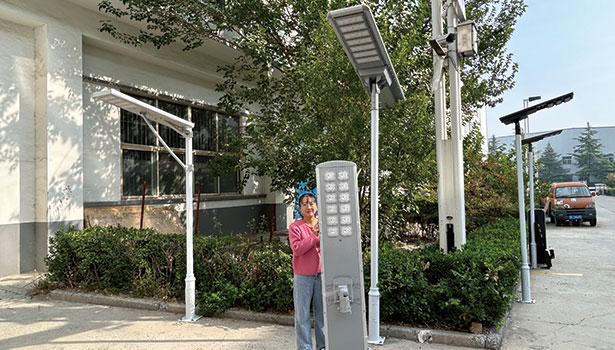
Refer to the surrounding environment: If the surrounding environment is dim, such as remote areas without other auxiliary lighting facilities, the solar street light is needed to provide higher brightness, and the number of lumens can be increased appropriately; if there are building lights and other auxiliary lighting in the surrounding area, the number of lumens of the solar street light can be reduced appropriately.
Seek professional advice: If you are not sure about the number of lumens required, you can consult solar street light suppliers or professional lighting designers. They have rich experience and can recommend the right number of lumens according to the actual situation of the specific installation location, such as the road width, the presence of curves, the surrounding vegetation, and so on. As a professional solar street light manufacturer with many years of experience, NOKIN can provide professional lighting program suggestions according to your needs, combined with a detailed survey of the installation site.
When choosing a solar street light, we have a variety of choices based on the type of technology used to generate the light. Some early solar street lights used common non-LED light sources with low efficiency and poor energy conversion. More modern options, such as high-efficiency LED light sources, offer higher energy efficiency and a longer lifespan.
LED solar street lights can reduce energy consumption by up to 90% and have a lifespan that is several times that of traditional non-LED solar street lights. Energy-saving products like LED solar street lights provide the same lumen brightness while relying less on solar panels and batteries, and can provide continuous and stable lighting under limited solar power conditions.
Brightness (lumens): Consider the required brightness of the installation location, usually measured in lumens. The higher the lumen value, the brighter the street light. For example, in the industrial park road lighting, in order to ensure the safe passage of large vehicles and personnel, you need to choose a higher number of lumens of solar street lights.
Energy consumption: the same lumen brightness, LED solar street light than traditional non-LED solar street light energy consumption is lower. When choosing, give priority to products with low energy consumption, which can reduce the long-term cost of use and reduce the pressure on the solar power supply system.
Color temperature: this will affect the atmosphere and visual effect created by street lighting. 2700K - 3000K street lights emit warm, comfortable light, suitable for parks, neighborhoods and other recreational areas; 4000K - 6000K street lamps have a colder, more refreshing effect, suitable for traffic routes, factories and other places that require a clear vision.
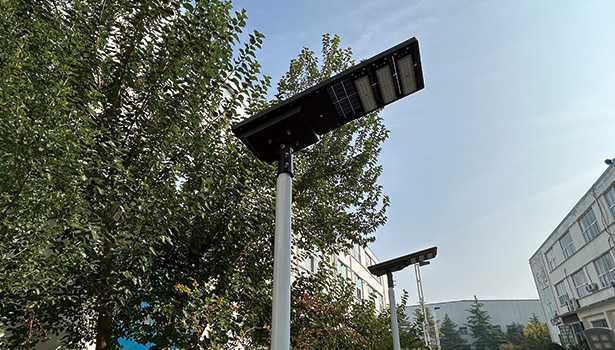
Solar panel and battery performance: the core of solar street light lies in the solar panel and battery. The conversion efficiency of the solar panel determines its ability to collect solar energy, the higher the conversion efficiency, the better. The capacity and life of the battery affects the life of the street light and the stability of use, to choose a large capacity, long life of the battery, such as lithium batteries compared to traditional lead-acid batteries, more advantageous in terms of performance.
Protection level: Since the solar street light is installed outdoors, it needs to have certain protection ability. The protection level is usually expressed by IPXX, the first X means dustproof level, and the second X means waterproof level. For example, IP65 rating means that the street light has excellent dustproof effect and can prevent water spray from all directions. In dusty or rainy areas, you should choose solar street lights with high protection level.
It is very important to choose solar street lights that are compatible with the installation environment. It is necessary to consider the light conditions of the installation location to ensure that the solar panel can obtain sufficient light time in a day. For example, in the road with heavy trees and more shade, it needs to be carefully selected, or by adjusting the installation position and angle to ensure that the solar panels receive light.
At the same time, it is necessary to determine the spacing of street lights according to the width of the road and the height of the lamp post. Generally speaking, the wider the road, the higher the pole, the street lamp spacing can be appropriately increased, but to ensure that the lighting without dead ends.
In some special terrain, such as mountainous roads at the bends, it may be necessary to adjust the installation angle and position of the street light to ensure the lighting effect. Careful planning of the installation details of solar street light can make it play the best performance and provide stable and reliable lighting service.
In solar street light, LED, i.e. Light Emitting Diode, is a highly efficient lighting element. It utilizes the movement of electrons within the diode substance to convert electrical energy directly into light.LED technology has many advantages, its high energy conversion rate, can produce high brightness light under low energy consumption, greatly reducing the dependence on solar power supply system.
At the same time, LED lamps have a long service life, reducing the maintenance costs of frequent replacement of lamps. In addition, the LED light response speed, can be instantly lit, and the light-emitting color can be adjusted according to demand, to meet the lighting needs of different scenes.
Color temperature is a key element of color appearance, which determines whether the white light emitted by the street light looks “warm” (yellowish) or “cool” (bluish). Warm light is about 2700 Kelvin (K), neutral white light is about 4000K, and cool white light is about 5000K or higher. Correlated Color Temperature (CCT) is expressed in Kelvin.
The difference in energy efficiency between cooler and warmer color temperatures is very small compared to the significant energy savings associated with converting from traditional non-LED solar streetlights to LED solar streetlights. The main difference between the different color temperatures is in the visual perception and application scenarios.
Warm color temperature street light to create a warm and comfortable atmosphere, suitable for creating a casual atmosphere of the place; cold color temperature street light can provide clear and bright lighting, more suitable for the need for a clear vision, to protect the traffic safety of traffic routes and other places.
The power supply system of solar street light mainly consists of solar panel, controller, battery and LED light. During the daytime, the solar panel converts solar energy into electricity under light conditions and stores the electricity in the battery through the controller.
The controller plays the role of regulation and protection to prevent the battery from overcharging or over-discharging. When the night falls and the ambient light becomes dark, the controller detects the light change and automatically turns on the circuit so that the battery supplies power to the LED light, thus realizing the lighting function.
In the whole process, the performance of the solar panel determines the collection efficiency of electricity, the capacity and quality of the battery affects the endurance of the street light, and the stability of the controller ensures the normal operation of the power system. Different regions have different light conditions, when choosing a solar street light, you need to reasonably configure the solar panels, batteries and other components according to the actual light conditions in the region to ensure that the street light can work stably and continuously.
Understanding the difference between wattage and lumens is crucial for the selection and application of solar street lights. We hope that the introduction of this article will help you make more demand-compliant and energy-efficient decisions in your future solar street light lighting projects.
What is wattage?
The association with solar street lights in traditional concepts
In the past, when selecting solar street lights, some people used to judge the lighting capacity based on the wattage. If you want the street light to be brighter, you will often choose a higher wattage. But in fact, the wattage is not an indicator of the brightness of the street light, but is used to measure the energy consumption, i.e. the amount of electricity consumed by the street light to produce light.
Impact on energy cost
The higher the wattage of a solar street light, the higher the power consumption, which may lead to insufficient battery life under the same solar power supply conditions, requiring more frequent maintenance and replacement of batteries, thereby increasing the cost of use.
Take a 40-watt solar street light as an example, under ideal lighting conditions, it consumes 40 watts of electricity per hour, which requires higher performance of solar panels and batteries.
Transformation brought about by energy-saving lighting
Nowadays, with technological advances, new types of energy-saving solar street lights are emerging. These fixtures are able to produce the same brightness (lumens) as higher wattage streetlights while consuming fewer watts (less energy). For example, whereas a 40-watt solar streetlight used to produce 380 to 460 lumens of light, the same brightness can now be achieved with just a 5-watt high-efficiency LED solar streetlight.
The relationship between wattage and energy efficiency
When comparing two solar streetlights with the same number of lumens (brightness) but different wattages, the lower the wattage, the more energy efficient the streetlight. The luminous efficiency of a lamp is usually measured in lumens per watt (lm/W), the higher the lumens per watt, the higher the efficiency of the lamp, and the more maintenance costs we can save in the long run.

What is lumen?
Definition as a measure of brightness
Lumen is the unit used to measure the brightness of the light. The higher the number of lumens, the brighter the light; the lower the number of lumens, the dimmer the light.
Importance in Modern Lighting Choices
Nowadays, when choosing solar street lights based on brightness, we should focus on the number of lumens rather than the number of watts. For example, a 5-watt LED solar street light is brighter than a 50-watt solar street light, and that's where lumens come into play. A 5-watt LED light produces approximately 450 - 500 lumens.
Relationship between LED lighting and lumens
LED lighting technology is widely used in the field of solar street lights, and it is able to maintain or even increase the number of lumens while reducing energy consumption. For example, if a 150-watt solar streetlight with a brightness of 2,600 lumens is replaced with a 25-watt LED solar streetlight, the energy consumption of the new streetlight will be significantly reduced, yet the brightness will remain the same. LED lighting technology reduces energy consumption by up to 93% compared to conventional high-wattage solar streetlights, thanks to the longer service life of LED lamps and their lower energy consumption. Therefore, LED solar street lights are not only more energy efficient, but also cheaper to use.
What is the difference between the wattage and lumen?
on the analogy of wattage
Wattage can be analogized to the speed of a car, but it measures not the speed, but the rate of energy flow in the power system. In the case of a solar streetlight system, the wattage reflects the rate at which the streetlight consumes electrical energy.
Analogy of lumens
Lumens, on the other hand, can be seen as a direct measure of brightness. This means that lumens measure the amount of visible light produced that is visible to the human eye, regardless of energy consumption (wattage). In the case of a solar street light, lumens determine how well it actually illuminates the road.

A quick guide to picking a solar street light
Street light type: Nowadays, solar street light technology is constantly being revolutionized and is no longer limited to the traditional high energy consumption styles. High-efficiency LED solar streetlights are becoming more mainstream, providing brighter lighting with lower energy consumption than earlier technologies.
Installation adaptation: When installing solar street lights, it is necessary to consider the adaptation of street lights with poles, solar panels and other components. Different installation scenarios, such as rural roads, urban main roads, etc., have different requirements on the installation method and angle of the street light, to ensure that the street light is stable and the solar panel can fully receive light.
Brightness considerations: After the previous discussion on wattage and lumens, we have understood that high wattage (high energy consumption) does not necessarily mean brighter (higher lumens). The good thing is that using lumens as a basic reference for brightness allows us to easily compare different solar street light products.
For example, when choosing solar street lights for community road lighting, according to the width of the road and the surrounding environment, choose the appropriate number of lumens of the product, not only to ensure the lighting effect, but also to avoid energy waste.
Color temperature factor: color temperature has nothing to do with the wattage and lumens, it refers to the degree of light “warm and cold”. Warm color temperature is similar to the traditional incandescent light bulbs issued by the light, to create a warm atmosphere; and cold light is more harsh, such as the common cold white LED light, can provide clear and bright lighting effect. In parks and other recreational areas, you can choose the warm color temperature of the solar street lamps; in the traffic avenue and other places that require a clear vision, it is suitable for the street lamps with cold color temperature.
How to convert lumens to wattage?
Understanding Wattage
Wattage is a unit to measure energy consumption. In solar street light system, although its energy comes from solar energy, the wattage also determines the consumption of electricity by the street light. For example, a 60-watt solar streetlight consumes 60 watts of electricity per hour, which means that a more powerful solar panel and a better quality battery are needed to guarantee its continuous power supply. Due to the limited technology of early solar street lights, there was a time when a specific brightness level was associated with a high wattage. But now, with the development of LED technology, which can produce more light at lower wattage, we can no longer judge the brightness simply based on the wattage, but need to choose based on the number of lumens.

Understanding Lumens
Lumen is a unit of visible light energy. The higher the lumen count, the brighter the light. Nowadays, all solar street light manufacturers will label lumens in the product parameters, so we can clearly understand the actual lighting brightness of each product. It may take some time to change from getting used to the wattage to getting used to the lumen count, but it is crucial for choosing the right solar street light.
Understanding light efficiency (lumens per watt)
After understanding wattage and lumens, we can combine the two to arrive at the number of lumens per watt, or “light efficiency” (or “luminous efficiency”). This value measures the ability of a light source to convert energy (watts) into light (lumens). Traditional solar streetlights with non-LED light sources have a luminous efficacy of only about 15 lumens/watt. LED solar street light technology typically achieves 75 - 110 lumens/watt, depending on the product and manufacturer.
Therefore, in general, LED solar street lights produce light approximately 7 times more efficiently than traditional solar street lights. When selecting an LED solar streetlight to replace a conventional solar streetlight, a roughly 7:1 ratio can be used as a reference.
For example, to replace a 60-watt conventional solar streetlight, divide 60 watts by 7 using this ratio and you will need approximately 9 watts of LED solar streetlight. However, luminous efficacy varies greatly from manufacturer to manufacturer, so it's best to check the product details and try to match the lumen count. Sometimes the product description will indicate the equivalent brightness of the LED Solar Street Light. You can also refer to the following chart. In the actual procurement of solar street lights, such as some large municipal projects, the purchaser will strictly follow the relationship between lumens and wattage, combined with the specific lighting needs, to screen the appropriate products.
| Streetlight Type | Luminous Efficacy (lm/W) |
| Traditional Solar Streetlight (Non-LED Light Source) | ~15 |
| LED Solar Streetlight | 75 - 110 |
How many lumens are needed?
lumens as a unit of measurement of energy-saving LED solar street lights
Nowadays, lumen (lm) is an important unit to measure the lighting effect of energy-saving LED solar street lights, and the number of lumens indicates the brightness of the street light. Compared with the wattage that measures the energy consumption of street lights, lumens can better measure the quality of light, which is directly related to the safety and comfort of road lighting.

Methods for determining the required number of lumens
Reference to the installation scene standards: different installation scenes have different requirements for lighting brightness. For example, rural roads with low traffic flow have relatively low requirements for street light brightness, which may require 10 - 20 lumens per square meter; while urban trunk roads with high traffic flow require clearer lighting, which may require 30 - 50 lumens per square meter. The number of lumens required for a solar street light can be determined according to industry standards for specific installation scenarios.
Refer to the surrounding environment: If the surrounding environment is dim, such as remote areas without other auxiliary lighting facilities, the solar street light is needed to provide higher brightness, and the number of lumens can be increased appropriately; if there are building lights and other auxiliary lighting in the surrounding area, the number of lumens of the solar street light can be reduced appropriately.
Seek professional advice: If you are not sure about the number of lumens required, you can consult solar street light suppliers or professional lighting designers. They have rich experience and can recommend the right number of lumens according to the actual situation of the specific installation location, such as the road width, the presence of curves, the surrounding vegetation, and so on. As a professional solar street light manufacturer with many years of experience, NOKIN can provide professional lighting program suggestions according to your needs, combined with a detailed survey of the installation site.
How to choose the right solar street light?
Overview of different lighting technologiesWhen choosing a solar street light, we have a variety of choices based on the type of technology used to generate the light. Some early solar street lights used common non-LED light sources with low efficiency and poor energy conversion. More modern options, such as high-efficiency LED light sources, offer higher energy efficiency and a longer lifespan.
LED solar street lights can reduce energy consumption by up to 90% and have a lifespan that is several times that of traditional non-LED solar street lights. Energy-saving products like LED solar street lights provide the same lumen brightness while relying less on solar panels and batteries, and can provide continuous and stable lighting under limited solar power conditions.
Factors to consider when choosing solar street lights
Brightness (lumens): Consider the required brightness of the installation location, usually measured in lumens. The higher the lumen value, the brighter the street light. For example, in the industrial park road lighting, in order to ensure the safe passage of large vehicles and personnel, you need to choose a higher number of lumens of solar street lights.
Energy consumption: the same lumen brightness, LED solar street light than traditional non-LED solar street light energy consumption is lower. When choosing, give priority to products with low energy consumption, which can reduce the long-term cost of use and reduce the pressure on the solar power supply system.
Color temperature: this will affect the atmosphere and visual effect created by street lighting. 2700K - 3000K street lights emit warm, comfortable light, suitable for parks, neighborhoods and other recreational areas; 4000K - 6000K street lamps have a colder, more refreshing effect, suitable for traffic routes, factories and other places that require a clear vision.

Solar panel and battery performance: the core of solar street light lies in the solar panel and battery. The conversion efficiency of the solar panel determines its ability to collect solar energy, the higher the conversion efficiency, the better. The capacity and life of the battery affects the life of the street light and the stability of use, to choose a large capacity, long life of the battery, such as lithium batteries compared to traditional lead-acid batteries, more advantageous in terms of performance.
Protection level: Since the solar street light is installed outdoors, it needs to have certain protection ability. The protection level is usually expressed by IPXX, the first X means dustproof level, and the second X means waterproof level. For example, IP65 rating means that the street light has excellent dustproof effect and can prevent water spray from all directions. In dusty or rainy areas, you should choose solar street lights with high protection level.
Ensure that the solar street light is compatible with the installation environment
It is very important to choose solar street lights that are compatible with the installation environment. It is necessary to consider the light conditions of the installation location to ensure that the solar panel can obtain sufficient light time in a day. For example, in the road with heavy trees and more shade, it needs to be carefully selected, or by adjusting the installation position and angle to ensure that the solar panels receive light.
At the same time, it is necessary to determine the spacing of street lights according to the width of the road and the height of the lamp post. Generally speaking, the wider the road, the higher the pole, the street lamp spacing can be appropriately increased, but to ensure that the lighting without dead ends.
In some special terrain, such as mountainous roads at the bends, it may be necessary to adjust the installation angle and position of the street light to ensure the lighting effect. Careful planning of the installation details of solar street light can make it play the best performance and provide stable and reliable lighting service.
Frequently Asked Questions
What are the advantages of LED technology in solar street light?
In solar street light, LED, i.e. Light Emitting Diode, is a highly efficient lighting element. It utilizes the movement of electrons within the diode substance to convert electrical energy directly into light.LED technology has many advantages, its high energy conversion rate, can produce high brightness light under low energy consumption, greatly reducing the dependence on solar power supply system.
At the same time, LED lamps have a long service life, reducing the maintenance costs of frequent replacement of lamps. In addition, the LED light response speed, can be instantly lit, and the light-emitting color can be adjusted according to demand, to meet the lighting needs of different scenes.
Does the color temperature affect the lighting efficiency of solar street light? What is the difference between different color temperatures?
Color temperature is a key element of color appearance, which determines whether the white light emitted by the street light looks “warm” (yellowish) or “cool” (bluish). Warm light is about 2700 Kelvin (K), neutral white light is about 4000K, and cool white light is about 5000K or higher. Correlated Color Temperature (CCT) is expressed in Kelvin.
The difference in energy efficiency between cooler and warmer color temperatures is very small compared to the significant energy savings associated with converting from traditional non-LED solar streetlights to LED solar streetlights. The main difference between the different color temperatures is in the visual perception and application scenarios.
Warm color temperature street light to create a warm and comfortable atmosphere, suitable for creating a casual atmosphere of the place; cold color temperature street light can provide clear and bright lighting, more suitable for the need for a clear vision, to protect the traffic safety of traffic routes and other places.
How does the power supply system of solar street light work?
The power supply system of solar street light mainly consists of solar panel, controller, battery and LED light. During the daytime, the solar panel converts solar energy into electricity under light conditions and stores the electricity in the battery through the controller.
The controller plays the role of regulation and protection to prevent the battery from overcharging or over-discharging. When the night falls and the ambient light becomes dark, the controller detects the light change and automatically turns on the circuit so that the battery supplies power to the LED light, thus realizing the lighting function.
In the whole process, the performance of the solar panel determines the collection efficiency of electricity, the capacity and quality of the battery affects the endurance of the street light, and the stability of the controller ensures the normal operation of the power system. Different regions have different light conditions, when choosing a solar street light, you need to reasonably configure the solar panels, batteries and other components according to the actual light conditions in the region to ensure that the street light can work stably and continuously.
Understanding the difference between wattage and lumens is crucial for the selection and application of solar street lights. We hope that the introduction of this article will help you make more demand-compliant and energy-efficient decisions in your future solar street light lighting projects.

